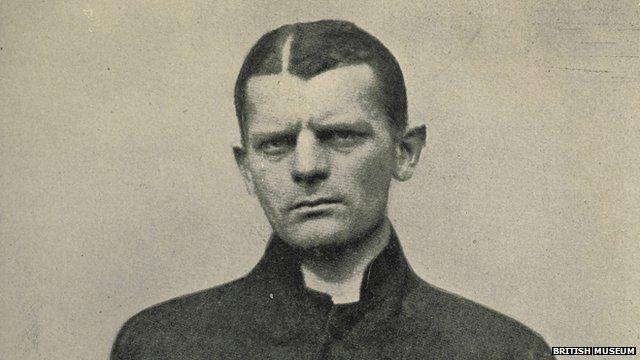World War One: Eleven shot at dawn in Tower of London
- Published

Carl Lody was the first spy to be shot in the Tower of London during World War One - he was executed on 6 November 1914
In November 1914, Carl Lody became the first person for more than 150 years to be executed in the Tower of London.
He was one of 11 German World War One spies who faced a firing squad at the famous London landmark, during World War One.
"The prisoner walked steadily, stiffly upright, and yet as easily and unconcerned as though he were going to a tea party, instead of to his death.
"The procession disappeared through the doorway of the sinister shed and shortly after came the muddled sound of a single volley - Carl Lody had paid!"
So wrote John Fraser, a Yeoman Warder in 1914.
Historic Royal Palaces Curator, Dr Sally Dixon-Smith, still finds it "really extraordinary" 11 convicted spies were shot at dawn, at a tourist attraction best known for containing the Crown Jewels.
"In fact, more people were executed within the walls of the Tower of London during the 20th Century than under the Tudors," she explained.
Len Sellers, author of Shot In The Tower, a book about German spies in WW1, said the Tower was chosen because of its sinister reputation.
"It was thought it would put a chill in the mind of an enemy spy and it might put him off doing what he was doing because he might be shot there," he said.
Most spies were arrested and tried after letters, newspapers or telegrams they had sent were intercepted by British intelligence.
'Brave man'
Ms Dixon-Smith calls the methods they used to conceal their messages as very "Boy's Own".
"A couple of them are using either lemon juice or peppermint oil as invisible ink, and some of the evidence against them is that they are found with lemons and pen nibs that have been really corroded by using the acidic lemon juice to write their messages," she said.
Primitive codes involving orders for cigars and sardines were also broken by intelligence officers.
Not all the men executed were German - there were also a Latvian, two Dutchmen, a Swede, a Turk and three men from South America. Their ages ranged from 22 to 57.
But, the Germans living in Britain were the ones vilified in the press at the outbreak of the war, leading the nation to be gripped with a collective spy fever.
"Germans staying here may be serving their country more effectively than by shouldering a rifle," warned the Daily Mail, six days after war was declared.
Despite this, there was sympathy for the convicted spies shown by their guards.
As he was being led off to be executed, Lody remarked to the Assistant Provost Marshal he would probably "not care to shake hands with a German spy".
"No," the marshal replied, "but I will shake hands with a brave man".
Lody had used the alias Charles Inglis, after getting a false passport in this name from the American consulate in Berlin.
He spent time in Edinburgh sending information to Germany on warships in the Firth of Forth.

The Tower's indoor firing range in 1910
Adrian Hill, an officer with the Honourable Artillery Company, guarded another spy, Carl Muller.
"He spoke perfect English and he talked to me very freely about his life, and I got to know him so well," Mr Hill remembered.
"It was a long night but what I did admire him for was that he was able to sleep.
"I had to tell him that this was the morning [of his execution] and he rubbed his eyes and said 'Oh good'."
'Graveyard memorial'
All but two of the executions were carried out in the Tower of London's indoor firing range. The other two were shot in the ditch surrounding the Tower.
"There would have been a chair there," said Yeoman Warden Kevin Kitcher. "[The prisoner] would have been sat down either with bandages or leather straps binding him to the chair.
"A bandage would have been put over the eyes, and shortly after that the execution would have taken place.
"One of the spies did ask for a lady's silk hanky to be tied [over his eyes] but it was a little bit short so they had to tie bandages to the hanky."
After execution the spies were buried at Plaistow cemetery in Newham, London.
"There is actually a tombstone to the first spy to be executed," said Ms Dixon-Smith, "And, a joint marker for all the men who were executed at the Tower and for other people who were executed during the First World War elsewhere."
The 12th man to be executed for spying during WW1, Robert Rosenthal, was hanged at Wandsworth jail on 15 July 1915.
There were no more executions after 1916 because, according to Mr Sellers, the Germans had "given up" on spying or had got very much better at it.
Hear how the German spies were betrayed and find out more from Frank Gardner on why journalists were threatened with execution in WW1.
- Published27 February 2014